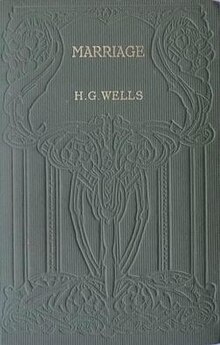 First edition (UK) | |
| Author | H. G. Wells |
|---|---|
| Country | United Kingdom |
| Language | English |
| Genre | Novel |
| Publisher | Macmillan (UK) Duffield & Co. (US) |
Publication date | 1912 |
| Pages | 551 |
Marriage is a 1912 novel by H. G. Wells.
 First edition (UK) | |
| Author | H. G. Wells |
|---|---|
| Country | United Kingdom |
| Language | English |
| Genre | Novel |
| Publisher | Macmillan (UK) Duffield & Co. (US) |
Publication date | 1912 |
| Pages | 551 |
Marriage is a 1912 novel by H. G. Wells.
Marriage features two protagonists: Marjorie Pope, the oldest daughter of a carriage manufacturer whose business has been ruined by the advent of the automobile, and R.A.G. Trafford, a physicist specializing in crystallography whom she marries against the wishes of her family at the age of 21. The novel traces the history of their relationship, which begins when an early airplane Trafford is piloting crashes into the garden of a house Marjorie's family is renting for the summer.
Marjorie ("Madge") and Trafford ("Rag") make great efforts to understand and accommodate the other. On Trafford's part, this leads to his abandonment of scientific research and his involvement with industrial commerce. He makes his fortune by applying himself to synthetic rubber. But he grows more and more disenchanted with his abandonment of his commitment to a life lived for truth. Marjorie's social ambitions gradually alienate him, and he decides to leave everything behind him and think things out in the wilderness of Labrador. His widowed mother persuades him to take Marjorie with him, and leaving their home and four children behind they undertake to survive the winter in the wilderness. There they nearly perish, but they save their marriage by winning their way through to a satisfactory mutual understanding. The novel ends as they are returning to London to undertake, together, a critical engagement with the world. Trafford intends to devote himself to writing a book entitled From Realism to Reality, which is to be "a pragmatist essay, a sustained attempt to undermine the confidence of all that scholasticism and logic chopping which still lingers like the sequelae of a disease in our University philosophy," while Marjorie intends to devote herself to being "his squaw and body-servant first of all, and then—a mother." [1]
The novel treats satirically the absurd artificiality of Edwardian literature, reform movements, social life, and so on. The social sphere that Wells portrays in Marriage is that of the wealthy bourgeoisie. But the novel preaches no particular political ideology, and its dénouement finds Trafford embracing and Marjorie accepting a diagnosis according to which humanity's fundamental problem is "the new, astonishing riddle of excessive power" [2] and a religious philosophy according to which "Salvation's a collective thing and a mystical thing—or there isn't any." [3]
At 551 pages, Marriage is one of H.G. Wells's longest novels. Biographers have noted that Wells drew on his own experiences in describing Trafford's situation, but the inner life of this chaste hero bears little resemblance to Wells's own turbulent private life.
Wells serialized the novel in the U.S. in the American Magazine from November 1911 to October 1912. [4] His need for income made him concerned when sales of the novel fell off after the first six months. [5] Reviews of the complex novel were mixed but mostly positive.
John M. Siddall of the American Magazine inquired about making a film version of the novel in 1919, and the rights to it were sold to Goldwyn Pictures in the early 1920s. A 56-minute film was released in 1927, with Alan Durant starring as Trafford and Virginia Valli playing Marjorie. In the film, Trafford leaves Marjorie and goes to Africa on a research expedition, and Marjorie follows him and wins back his love. [6] No prints of this film are known to survive. [7]

The Outline of History, subtitled either "The Whole Story of Man" or "Being a Plain History of Life and Mankind", is a work by H. G. Wells chronicling the history of the world from the origin of the Earth to the First World War. It appeared in an illustrated version of 24 fortnightly installments beginning on 22 November 1919 and was published as a single volume in 1920. It sold more than two million copies, was translated into many languages, and had a considerable impact on the teaching of history in institutions of higher education. Wells modeled the Outline on the Encyclopédie of Denis Diderot.
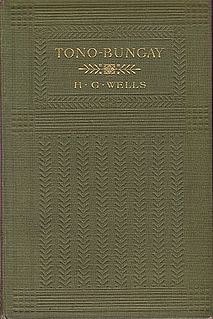
Tono-Bungay is a realist semiautobiographical novel written by H. G. Wells and first published in book form in 1909. It has been called "arguably his most artistic book". It had been serialised before book publication, both in the United States, in The Popular Magazine, beginning in the issue of September 1908, and in Britain, in The English Review, beginning in the magazine's first issue in December 1908.

The Science of Life is a book written by H. G. Wells, Julian Huxley and G. P. Wells, published in three volumes by The Waverley Publishing Company Ltd in 1929–30, giving a popular account of all major aspects of biology as known in the 1920s. It has been called "the first modern textbook of biology" and "the best popular introduction to the biological sciences". Wells's most recent biographer notes that The Science of Life "is not quite as dated as one might suppose".

Kipps: The Story of a Simple Soul is a novel by H. G. Wells, first published in 1905. Humorous yet sympathetic, the perceptive social novel is generally regarded as a masterpiece, and it was his own favourite work.
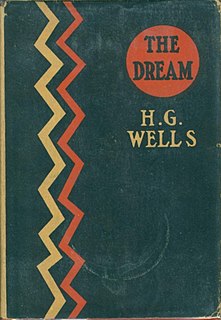
The Dream is a 1924 novel by H. G. Wells about a man from a Utopian future who dreams the entire life of an Englishman from the Victorian and Edwardian eras, Harry Mortimer Smith. As in other novels of this period, in The Dream Wells represents the present as an "Age of Confusion" from which humanity will be able to emerge with the help of science and common sense.

New Worlds for Old (1908), which appeared in some later editions with the subtitle "A Plain Account of Modern Socialism," was one of several books and pamphlets that H. G. Wells wrote about the socialist future in the period 1901-1908, while he was engaged in an effort to reform the Fabian Society.

The Wonderful Visit is an 1895 novel by H. G. Wells. With an angel—a creature of fantasy unlike a religious angel—as protagonist and taking place in contemporary England, the book could be classified as contemporary fantasy, although the genre was not recognised in Wells's time. The Wonderful Visit also has strong satirical themes, gently mocking customs and institutions of Victorian England as well as idealistic rebellion itself.

Mr. Britling Sees It Through is H.G. Wells's "masterpiece of the wartime experience in south eastern England." The novel was published in September 1916.

The Soul of a Bishop is a 1917 novel by H. G. Wells.
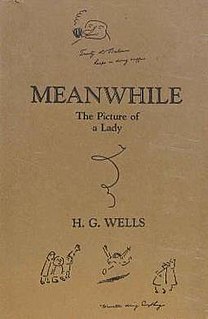
Meanwhile is a 1927 novel by H. G. Wells set in an Italian villa early in 1926. It was chosen as an alternate selection of the recently founded Book of the Month Club and was translated into a number of languages, including Danish, Norwegian, Polish, and Czech. In England, 30,000 copies sold within two months, and by the summer of 1929 50,000 had been sold.
The New Machiavelli is a 1911 novel by H. G. Wells that was serialised in The English Review in 1910. Because its plot notoriously derived from Wells's affair with Amber Reeves and satirised Beatrice and Sidney Webb, it was "the literary scandal of its day".

First and Last Things is a 1908 work of philosophy by H. G. Wells setting forth his beliefs in four "books" entitled "Metaphysics," "Of Belief," "Of General Conduct," and "Some Personal Things." Parts of the book were published in the Independent Magazine in July and August 1908. Wells revised the book extensively in 1917, in response to his religious conversion, but later published a further revision in 1929 that restored much of the book to its earlier form. Its main intellectual influences are Darwinism and certain German thinkers Wells had read, such as August Weismann. The pragmatism of William James, who had become a friend of Wells, was also an influence.
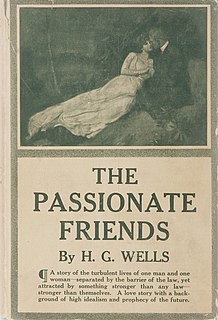
The Passionate Friends is a 1913 novel by H. G. Wells.

Bealby: A Holiday is a 1915 comic novel by H. G. Wells.
God the Invisible King is a theological tract published by H. G. Wells in 1917.

War and the Future (1917) is a work of war propaganda by H. G. Wells that was published in North America under the title Italy, France, and Britain at War. Wells would have preferred the title The War of Ideas, but his publisher over-ruled him. Except for the opening piece, its chapters were published as articles in the press. Though proclaiming early in the volume that "I avow myself an extreme Pacifist," Wells staunchly supported Britain's war against Germany "in the hope that so we and the world may be freed from the German will-to-power and all its humiliating and disgusting consequences henceforth for ever."

Experiment in Autobiography is an autobiographical work by H.G. Wells, originally published in two volumes. He began to write it in 1932, and completed it in the summer of 1934.

The Bulpington of Blup, a 1932 novel by H. G. Wells, is a character study analyzing the psychological sources of resistance to Wellsian ideology, and was influenced by Wells's acquaintance with Carl Gustav Jung and his ideas.

Joan and Peter, a 1918 novel by H. G. Wells, is at once a satirical portrait of late-Victorian and Edwardian England, a critique of the English educational system on the eve of World War I, a study of the impact of that war on English society, and a general reflection on the purposes of education. Wells regarded it as "one of the most ambitious" of his novels.

Anticipations of the Reaction of Mechanical and Scientific Progress upon Human Life and Thought, generally known as Anticipations, was written by H.G. Wells at the age of 34. He later called the book, which became a bestseller, "the keystone to the main arch of my work." His most recent biographer, however, calls the volume "both the starting point and the lowest point in Wells's career as a social thinker."
{{cite web}}: CS1 maint: archived copy as title (link) accessed April 16, 2012.